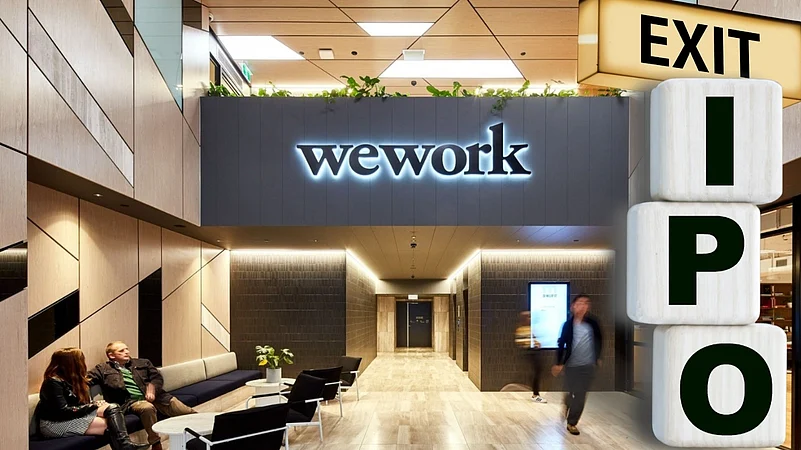There’s a flurry of DRHPs (draft red herring prospectus) popping up across various sectors in India, with co-working companies also joining the fray. After Awfis and Smartworks IPOs, WeWork India has also thrown its hat in the ring. It recently got a nod from the Securities and Exchange Board of India (Sebi) to go public this year. The company's timing looks ideal as demand for flexible workspaces is soaring.
As per Colliers India data, co-working centre operators have rented nearly 65 lakh square feet of office space in the first six months of 2025, an increase of nearly 48% annually. The real estate research firm attributed the growth to rising demand for managed and flexible workspaces from corporates.
While the sector is high on corporate demand and rapid expansion, WeWork India’s public listing takes a different turn with 100% offer for sale, which means no fresh capital will be infused into the business. Instead, all proceeds – after deducting relevant taxes and offer-related expenses – will go to the selling shareholders.
The company’s DRHP stated that the IPO launch will only focus on improving WeWork’s market visibility and offer an exit or liquidity to existing shareholders. “There is no direct fund infusion into the business from this offering,” it read.
In short, there is no pressing need for capital and management is hesitant to reinvest. Industry experts are also apprehensive about how strong the company’s financial health really is given the 100% OFS, and how ambitious its future plans might be.
Who Will Really Benefit from The IPO?
Market experts says the promoters stand to gain the most from the IPO in its current form. According to Kresha Gupta, Director and Fund Manager at Steptrade Capital, the promoters will benefit the most from the 100% OFS structure. The existing shareholders will get liquidity without waiting for an acquisition, buyback, or internal restructuring.
“It’s essentially a partial exit with the added benefit of brand value and credibility from a public listing. For them, it's a way to monetise their years of effort and capital,” she says.
The company, however, will only gain indirectly from the ₹3,500-4,000 crore IPO expected to be launched in August 2025. “The listing brings better visibility, governance, and market valuation, which can help in future rounds or strategic mergers & acquisitions”.
The offer for sale includes up to 4.37 crore equity shares, of which promoter entity Embassy Buildcon LLP plans to sell up to 3.34 crore shares and investor 1 Ariel Way Tenant offloading up to 1.02 crore shares. Their average cost of acquisition for these shares stands at ₹162.83 and ₹65.88 per share, respectively.
Since this is a secondary sale, the company won’t get anything from the IPO proceeds, and all the proceeds from the OFS will go to the existing shareholders selling their shares. The issue has been structured to allocate 75% of the issue to qualified institutional buyers (QIBs), 15% to non-institutional investors (NIIs), and 10% to retail investors. In addition, nearly 5% of the post-offer equity is reserved for eligible employees.
Is WeWork India IPO a Risky Bet?
Experts are divided on WeWork India’s 100% OFS IPO strategy. While some says that it may signal financial stability and a strategic liquidity move by promoters, others believe that it also raises questions about the company’s financials and long-run goals.
“Without fresh equity, future investment must come from internal accruals or debt, underscoring a cautious, self-funded strategy. This could signal maturity or contentment with current scale—or a preference for stability over aggressive expansion, which might hamper long-term competitiveness,” says Shivani Nyati, Head of Wealth, Swastika Investmart Ltd.
In contrast, Steptrade’s Gupta believes the model reduces promoters’ shareholding and skin in the game, which may impact long-term alignment, especially at a time when competitors are expanding aggressively and have cleaner profitability trends.
“It’s not a straight red flag. After all, for a company to get listed, it must pass through multiple levels of scrutiny from regulatory and approving authorities like Sebi. So we can’t outright label the IPO structure as negative. But yes, it’s certainly a riskier bet,” the fund manager notes.
Even the company acknowledges potential risks in DRHP, just like everyone does. These include bulk profit coming from Mumbai and Bengaluru, impact of macroeconomic headwinds, long-term lease agreements, and more.
As per its draft papers, nearly 70% of the revenue came from net membership fees located in Bengaluru and Mumbai. This means that any adverse developments affecting such locations and centres could have an adverse effect on the business and impact profitability. Till September 2024, WeWork had 59 operational centres across eight cities In India.
Several macroeconomic factors that might impact demand are global/ domestic recession, lower infrastructure spending, reduction in purchasing power, inflation, ageing population, evolving job markets, and more.
“Our inability to effectively manage the fixed lease expenses under long-term lease agreements entered into with landlords may result in an increase in our total costs, which may adversely affect our business, cash flows, profitability, results of operation, and financial position,” it added.
What Numbers Say About WeWork India?
The co-working major swung to profitability in the first half of FY25. It reported a net profit of ₹174.13 crore, driven by strong demand for premium co-working spaces. Its total income for the April-September 2024 period also stood at ₹960.76 crore, the DRHP filed with Sebi revealed.
This marks a significant turnaround from the previous fiscal year (FY24), when the company reported a net loss of ₹135.83 crore, despite recording ₹1,737.16 crore in revenues. As of mid-January 2024, WeWork India’s net debt stood at ₹316.95 crore.
Hence, the company raised ₹500 crore through a rights issue earlier this year to pare debt and support growth plans.
The recent profitability might give WeWork India some breathing room, but questions still linger around the sustainability of its growth. Experts caution that in capital-intensive models like co-working, profitability can be temporary unless supported by consistent expansion and high occupancy.
As Gupta explains, losses occurred due to growth costs like new leases and marketing, which are manageable. But without fresh capital coming in, future expansion may slow down or start affecting margins.
Besides numbers, what sets WeWork India apart is the different business model and strategy from its global parent. Simran Patel, Investment Associate, All In Capital, says that WeWork India has fundamentally shifted from the global historically problematic model.
“They've now moved toward enterprise clients – about 60% of its revenue or net membership fees in 2024 came from enterprises in stark contrast to the global entity's original focus on start-ups and freelancers. Unlike the global parent's asset-heavy model that led to bankruptcy, WeWork India has achieved profitability,” she said.
WeWork India, founded in 2017, operates under an exclusive brand licensing agreement with WeWork Global. It is majorly owned (76.21%) by Embassy Group, and its global parent holds the remaining 23.45%, which had even invested $100 million into the Indian entity in June 2021.
Will WeWork India Find Its Edge in Co-working?
While WeWork India has distanced itself from the global parent’s missteps, the real test lies in whether the Indian business model can endure in this highly competitive and cost-sensitive market. Experts also note that brand ‘moats’ in co-working are limited.
“WeWork India's market position is defensible in the short-run. Their scale advantage is significant – operating costs benefit from economies of scale, and they can negotiate better lease terms due to their portfolio size. Although the real win will be their ability to pass on these costs to customers while maintaining occupancy rates,” says Patel.
Even as demand holds steady, market maturing also brings its own set of pressures. Peush Jain of Anarock Group states that co-working’s share in overall office leasing has stabilised at around 20-24%.
To be specific, the demand for co-working remains strong from corporates to enhance employee productivity, foster collaboration, and optimise operational costs by scaling up or down as per business requirements, according to Manas Mehrotra of 315Work Avenue.
Hence, WeWork India’s challenge isn’t just about scaling up; it’s about scaling smart. The company’s ability to retain enterprise clients, protect margins, and stay agile amid shifting market dynamics will decide if its recent turnaround becomes a long-term success story, or just a well-timed rebound.
































